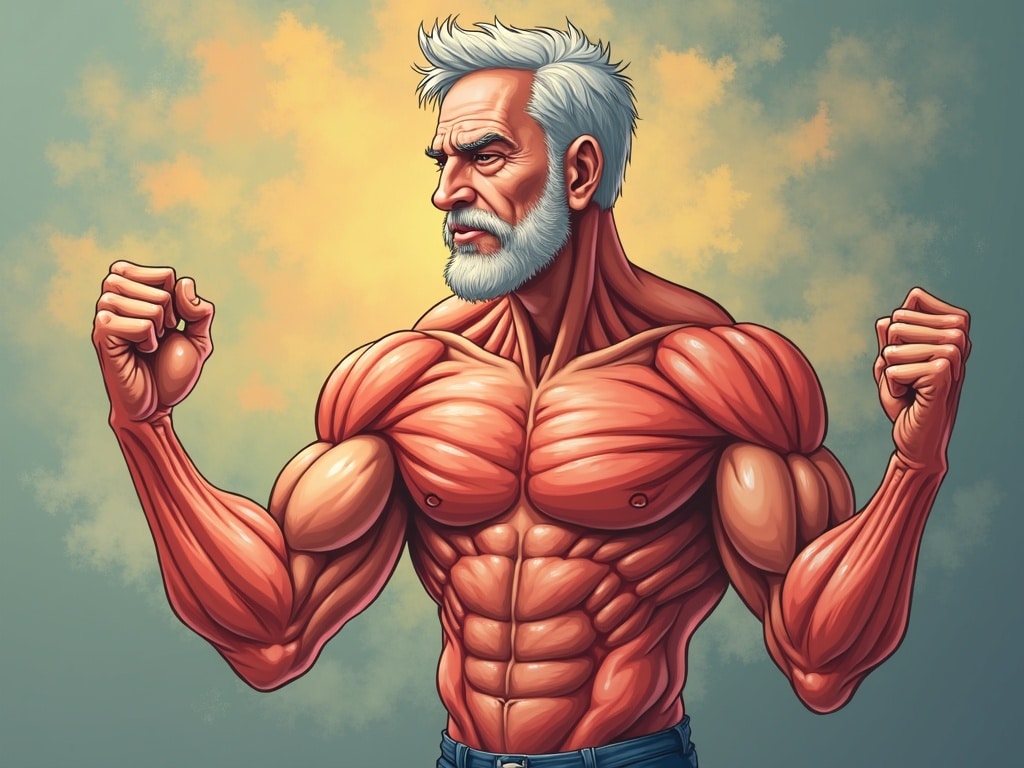How to Maintain Muscle Mass as You Age: A Comprehensive Guide
Picture this: you’re in your prime, effortlessly lifting groceries, bounding up stairs, and feeling strong and capable. But as the years tick by, you might notice a gradual decline in your physical prowess. This isn't just about aesthetics; it's about maintaining your independence, vitality, and overall health. The good news? You absolutely can fight the natural decline of muscle mass that comes with aging. This guide will provide you with actionable strategies to not only maintain but even build muscle as you gracefully navigate the golden years.
Understanding Sarcopenia: The Age-Related Muscle Loss
Sarcopenia, the age-related loss of muscle mass and strength, is a real concern. It typically begins around age 30 and accelerates after 60. Don’t let that number scare you! Understanding what’s happening in your body is the first step to taking control.
Several factors contribute to sarcopenia:
- Decreased Hormone Levels: Lower levels of growth hormone, testosterone (in men), and estrogen (in women) play a significant role.
- Reduced Physical Activity: A sedentary lifestyle speeds up muscle loss. Use it or lose it is especially true as we age.
- Poor Nutrition: Inadequate protein intake and overall poor eating habits hinder muscle protein synthesis.
- Inflammation: Chronic inflammation, common in older adults, can break down muscle tissue.
- Neurological Changes: Decreases in the number and function of motor neurons can impair muscle activation.
Sarcopenia isn’t just about weaker biceps. It's linked to:
- Increased risk of falls and fractures
- Decreased mobility and independence
- Reduced metabolic rate, leading to weight gain
- Increased risk of chronic diseases like type 2 diabetes and heart disease
- Lower quality of life
The Power of Protein: Fueling Your Muscles
Protein is the cornerstone of muscle maintenance and growth. Think of it as the raw material your body uses to repair and rebuild muscle tissue after exercise. As we age, our bodies become less efficient at processing protein, so it becomes even more crucial to ensure adequate intake.
How Much Protein Do You Need?
The Recommended Dietary Allowance (RDA) for protein is 0.8 grams per kilogram of body weight per day. However, for older adults aiming to preserve or build muscle, experts often recommend a higher intake, ranging from 1.0 to 1.2 grams per kilogram of body weight per day, or even higher depending on activity level and individual needs. Consult with a registered dietitian or healthcare professional to determine the right amount for you.
Here's a simple way to calculate your approximate daily protein needs:
- Convert your weight from pounds to kilograms: Divide your weight in pounds by 2.2.
- Multiply your weight in kilograms by your target protein intake (e.g., 1.0 to 1.2 grams).
For example, a 150-pound person aiming for 1.1 grams of protein per kilogram would need approximately 75 grams of protein per day (150 lbs / 2.2 = 68 kg; 68 kg x 1.1 g/kg = 75 g).
Excellent Protein Sources to Incorporate Into Your Diet:
- Lean Meats: Chicken breast, turkey, lean beef, and pork tenderloin are excellent sources of high-quality protein.
- Fish: Salmon, tuna, cod, and other fish are packed with protein and omega-3 fatty acids, which are beneficial for overall health.
- Eggs: A complete protein source, eggs are versatile and affordable.
- Dairy: Greek yogurt, cottage cheese, and milk are good sources of protein and calcium.
- Legumes: Beans, lentils, and chickpeas are plant-based protein powerhouses.
- Nuts and Seeds: Almonds, walnuts, chia seeds, and flaxseeds provide protein, healthy fats, and fiber.
- Protein Supplements: Whey protein, casein protein, and plant-based protein powders can be helpful for supplementing your diet, especially after workouts. Consult with a healthcare professional before starting any new supplement.
Tips for Optimizing Protein Intake:
- Spread your protein intake throughout the day: Aim for 20-30 grams of protein per meal to maximize muscle protein synthesis.
- Prioritize protein at breakfast: Start your day with a protein-rich meal to kickstart muscle recovery and help you feel fuller for longer. Oatmeal with protein powder and berries, or eggs with whole-wheat toast are good options.
- Combine protein with healthy carbohydrates: This helps to shuttle amino acids (the building blocks of protein) into your muscles.
- Consider a bedtime protein snack: Casein protein, a slow-digesting protein, can help prevent muscle breakdown overnight.
Resistance Training: Your Anti-Aging Weapon
Resistance training, also known as strength training or weight training, is the most effective way to combat sarcopenia and maintain muscle mass as you age. It involves working your muscles against resistance, which stimulates muscle growth and strengthens your bones and connective tissues.
Why Resistance Training is So Important:
- Stimulates Muscle Protein Synthesis: Resistance training signals your body to build and repair muscle tissue.
- Increases Bone Density: Weight-bearing exercise helps to prevent osteoporosis and reduces the risk of fractures.
- Improves Balance and Coordination: Strength training enhances your ability to maintain balance, reducing the risk of falls.
- Boosts Metabolism: Muscle tissue burns more calories than fat tissue, so building muscle helps to increase your metabolic rate.
- Enhances Functional Fitness: Resistance training improves your ability to perform everyday activities, such as lifting groceries, climbing stairs, and gardening.
Getting Started with Resistance Training:
- Consult with Your Doctor: Before starting any new exercise program, especially if you have any underlying health conditions, talk to your doctor.
- Work with a Qualified Trainer: A certified personal trainer can design a safe and effective workout program tailored to your individual needs and goals. They can also teach you proper form to prevent injuries.
- Start Slowly and Gradually Increase Intensity: Begin with bodyweight exercises or light weights and gradually increase the weight, repetitions, or sets as you get stronger.
- Focus on Compound Exercises: These exercises work multiple muscle groups simultaneously and are more efficient for building overall strength. Examples include squats, lunges, push-ups, rows, and overhead presses.
- Aim for 2-3 Strength Training Sessions Per Week: Allow your muscles adequate rest and recovery between workouts.

Sample Resistance Training Exercises for Older Adults:
- Squats: Stand with your feet shoulder-width apart, and lower your hips as if you're sitting in a chair. Keep your back straight and your core engaged.
- Lunges: Step forward with one leg and lower your body until both knees are bent at a 90-degree angle. Keep your front knee behind your toes.
- Push-ups: Start in a plank position with your hands shoulder-width apart. Lower your body until your chest touches the floor, then push back up to the starting position. Modify on your knees if needed.
- Rows: Use dumbbells or resistance bands to pull your elbows back towards your body, squeezing your shoulder blades together.
- Overhead Presses: Lift dumbbells or a barbell overhead, keeping your core engaged and your back straight.
- Bicep Curls: Curl dumbbells towards your shoulders, keeping your elbows close to your body.
- Triceps Extensions: Extend dumbbells overhead, keeping your elbows close to your head.
- Calf Raises: Stand on a slightly elevated surface and raise up onto your toes, squeezing your calf muscles.
Beyond Protein and Weights: Additional Strategies for Muscle Health
While protein and resistance training are the cornerstones of muscle maintenance, other factors play a significant role in overall muscle health.
Prioritize Sleep:
Adequate sleep is essential for muscle recovery and growth. Aim for 7-9 hours of quality sleep each night. During sleep, your body releases growth hormone, which helps to repair and rebuild muscle tissue. Lack of sleep can increase cortisol levels, which can break down muscle.
Manage Stress:
Chronic stress can lead to increased cortisol levels, which can contribute to muscle breakdown. Find healthy ways to manage stress, such as exercise, meditation, yoga, or spending time in nature.
Stay Hydrated:
Water is crucial for all bodily functions, including muscle function. Dehydration can impair muscle performance and hinder recovery. Aim to drink plenty of water throughout the day. A good rule of thumb is to drink half your body weight in ounces of water daily.
Consider Creatine Supplementation:
Creatine is a naturally occurring compound that helps to increase muscle strength and power. It's one of the most well-researched and safe supplements available. Creatine supplementation may be particularly beneficial for older adults looking to maintain or build muscle. Consult with your doctor before starting any new supplement.
Address Underlying Health Conditions:
Certain medical conditions, such as diabetes, heart disease, and thyroid disorders, can contribute to muscle loss. Work closely with your healthcare provider to manage any underlying health conditions and optimize your overall health. Proper management of these conditions is crucial for maintaining muscle mass as you age. Addressing inflammation through diet and lifestyle changes can also be beneficial.
The Importance of Consistency
Maintaining muscle mass as you age is a marathon, not a sprint. Consistency is key. Stick to your resistance training program and maintain a protein-rich diet. Small, consistent efforts over time will yield significant results.
Listen to Your Body
Perhaps the most important piece of advice is to listen to your body. Don't push yourself too hard, especially when starting a new exercise program. Pay attention to any pain or discomfort and adjust your training accordingly. Rest and recovery are just as important as the workouts themselves.
Embrace the Journey
Maintaining muscle mass as you age is about more than just physical appearance; it's about preserving your independence, vitality, and quality of life. By prioritizing protein intake, engaging in regular resistance training, and adopting healthy lifestyle habits, you can defy the aging process and stay strong, active, and vibrant for years to come. Embrace the journey and celebrate the strength and resilience of your body.

